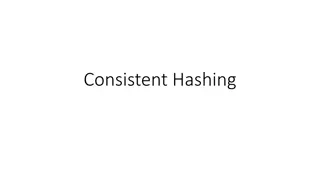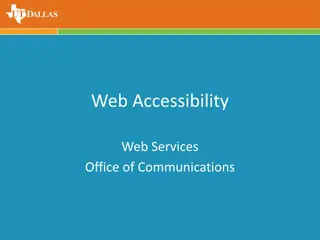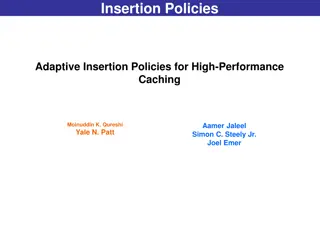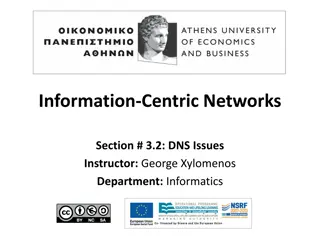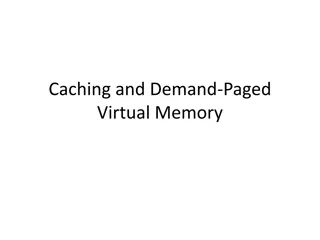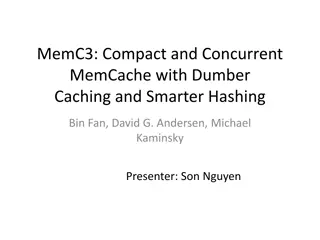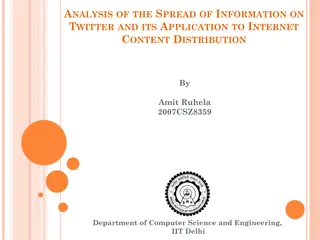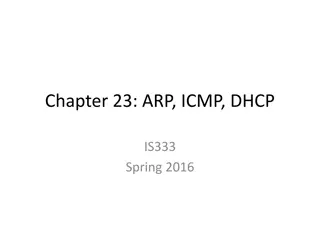Understanding Web Caching: An Overview
Web caching, implemented through various types of caches like browser cache, proxy cache, and gateway cache, plays a crucial role in improving content availability, reducing network congestion, and enhancing user experience by saving bandwidth and decreasing latency. It addresses the challenges posed by the rapid growth of HTTP traffic and increasing demand for web content. Learn about the benefits, classification of caches, and scenarios where web caching is beneficial or not.
Download Presentation

Please find below an Image/Link to download the presentation.
The content on the website is provided AS IS for your information and personal use only. It may not be sold, licensed, or shared on other websites without obtaining consent from the author. Download presentation by click this link. If you encounter any issues during the download, it is possible that the publisher has removed the file from their server.
E N D
Presentation Transcript
Web Cache Directed by: Eng. karam al-sofy
Introduction what is web cache? Introducing proxy servers at certain points in the network that serve in caching Web documents for faster client access. Comparable to the cache memory in a computer system. Why is it needed ? Rapid growth in HTTP traffic to form the largest part of the Internet traffic which causes more network congestion and server unavailability. The number of Web static pages almost doubles every year.
The Expected gains Bandwidth saving Improving content availability. Improving web server availability. Reducing network latency. Server load balancing. Improving user s perception about network s performance = Response Time.
This Is Ok If.. 1.Not a lot of content 2.Small amount of users/page views This Is Bad If .. 1.Lots of contents 2.Lots of users/page views
Classification of caches according to the location Browser cache (User Agent Cache) Single user Proxy Cache (Shared Cache) Multi-user (Surrogate Cache) Gateway Cache Multi-user
Browser Cache Implemented on a single user s machine. Local hard drive space stores representation of viewed content. Simple rules for control. Usefulness Recently viewed pages (Back/Forward button) Commonly used images
Proxy Cache Similar concept, but for multiple users. Usually implemented on a firewall or separate device known as intermediaries. Request routing can be manually or through an interception proxy. Usefulness Latency and network traffic are reduced
Gateway Cache Also known as reverse proxy caches. Implemented on separate devices by a website administrator. Distributed gateway caches are used in Content Delivery Networks (CDN). Usefulness Increased scalability, reliability, and performance
Types of Caches Simple Proxy (Normal/Regular) Transparent Proxy Reverse Proxy Adaptive Caching Push Caching Active Caching Streaming Caches
Normal (regular cache)proxy A regular caching proxy server is a server which listens on a separate port (e.g. 3128) and the clients (browsers) are configured to send requests for connectivity to that port. So the proxy server receives the request, fetches the content and stores a copy for future use. So next time when another client requests for the same webpage the proxy server just replies to the request with the content in its cache thus improving the overall request-reply speed.
Transparent Proxy A transparent proxy server is also a caching server but the server is configured in such a way that it eliminates the client side (browser side) configuration. Typically the proxy server resides on the gateway and intercepts the WWW requests (port 80, 443 etc.) from the clients and fetches the content for the first time and subsequently replies from its local cache. The name Transparent is due to the fact that the client doesn't know that there is a proxy server which mediates their requests. Transparent proxy servers are mostly used in big corporate organizations configuration is not easy (due to the number of clients). This type of server is also used in ISP's to reduce the load on the bandwidth usage. where the client side
Advantage & Disadvantage of use transparent proxy No client configuration. Violates end-to-end paradigm Client thinks it is talking directly to server Server thinks it is talking to cache Implemented as Pass-through unit L4 switch
Advantage & Disadvantage (continued) Only port 80 FTP not supported To be efficient modern browsers are required No user control. Users can t bypass the cache Stability / Reliability
Reverse Proxy: A reverse proxy is totally different in its usage because it is used for the benefit of the web server rather than its clients. Basically a reverse proxy is on the web server end which will cache all the static answers from the web server and reply to the clients from its cache to reduce the load on the web server. This type of setup is also known as Web Server Acceleration.
Adaptive Web Caching - Uses distributed cache meshes to solve the hot spot problem Caches dynamically join and leave the groups based on content demand Administrative boundaries must be relaxed Push Caching Keep data close to those clients requesting this information Assumption: we are able launch caches that may cross administrative boundaries Incurs cost (storage and transmission)
Active Caching Applies caching to dynamic documents 30 % of client HTTP requests contains cookies The servers provides the cache with the objects and any associated cache applets
Higher Level Caching 1. SQUID Squid is a free, open source(based on Lunix) , proxy caching server for web clients. It operates as an intermediary between the web browsers (clients) and the server they access. Technically, A proxy server can simply to manage traffic between a web server and the clients that want to communicate with it, without doing caching at all. Squid combine both capabilities as a server.
SQUID (continued) It supports transparent proxying. It works on port no. 3128. Extensive access controls and great server accelerator. It support following protocols (HTTP,HTTPS,DNS,FTP,SSL,ICP,HTCP,SNMP) Three main components (client side, server side, storage manager)
2. Varnish: it is a program that is designed to act as a proxy server (reverse) and high- performance storage, a HTTP accelerator. 3. XtraDB: If you are using a My SQL database, this caching solution can help optimize performance of your database better than the standard InnoDB
Hierarchical Caching Caches are arranged in a tree-like structure A child cache can query parent caches and other siblings A parent cache can never query children This maintains information gradually filtering down to the leaves To avoid swamping parents with information, clustering may be applied to hierarchies.
Cache control HTTP defines three basic mechanisms for controlling caches: freshness, validation, and invalidation Freshness allows a response to be used without re- checking it on the origin server, and can be controlled by both the server and the client. For example, the Expires response header gives a date when the document becomes stale, and the Cache- Control: max-age directive tells the cache how many seconds the response is fresh for.
Validation can be used to check whether a cached response is still good after it becomes stale. For example, if the response has a Last-Modified header, a cache can make a conditional request using the If- Modified-Since header to see if it has changed. The ETag (entity tag) mechanism also allows for both strong and weak validation. Invalidation is usually a side effect of another request that passes through the cache. For example, if a URL associated with a cached response subsequently gets a POST, PUT or DELETE request, the cached response will be invalidated.





